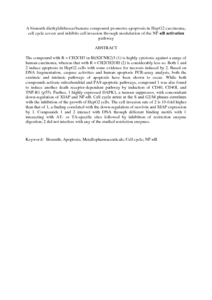Citation
Abang Ishak, Dayang Hazwani and Ooi, Kah Kooi and Ang, Kok Pian and Md. Akim, Abdah and Cheah, Yoke Kqueen and Nordin, Norshariza and Abdul Halim, Siti Nadiah and Seng, Hoi Ling and Tiekink, Edward R. T.
(2014)
A bismuth diethyldithiocarbamate compound promotes apoptosis in HepG2 carcinoma, cell cycle arrest and inhibits cell invasion through modulation of the NF-κB activation pathway.
Journal of Inorganic Biochemistry, 130.
pp. 38-51.
ISSN 0162-0134; ESSN: 1873-3344
Abstract
The compound with R = CH2CH3 in Bi(S2CNR2)3 (1) is highly cytotoxic against a range of human carcinoma, whereas that with R = CH2CH2OH (2) is considerably less so. Both 1 and 2 induce apoptosis in HepG2 cells with some evidence for necrosis induced by 2. Based on DNA fragmentation, caspase activities and human apoptosis PCR-array analysis, both the extrinsic and intrinsic pathways of apoptosis have been shown to occur. While both compounds activate mitochondrial and FAS apoptotic pathways, compound 1 was also found to induce another death receptor-dependent pathway by induction of CD40, CD40L and TNF-R1 (p55). Further, 1 highly expressed DAPK1, a tumour suppressor, with concomitant down-regulation of XIAP and NF-κB. Cell cycle arrest at the S and G2/M phases correlates with the inhibition of the growth of HepG2 cells. The cell invasion rate of 2 is 10-fold higher than that of 1, a finding correlated with the down-regulation of survivin and XIAP expression by 1. Compounds 1 and 2 interact with DNA through different binding motifs with 1 interacting with AT- or TA-specific sites followed by inhibition of restriction enzyme digestion; 2 did not interfere with any of the studied restriction enzymes.
Download File
![[img]](http://psasir.upm.edu.my/36121/1.hassmallThumbnailVersion/A%20bismuth%20diethyldithiocarbamate%20compound%20promotes%20apoptosis%20in%20HepG2%20carcinoma.pdf)  Preview |
|
PDF (Abstract)
A bismuth diethyldithiocarbamate compound promotes apoptosis in HepG2 carcinoma.pdf
Download (271kB)
| Preview
|
|
Additional Metadata
Actions (login required)
 |
View Item |

